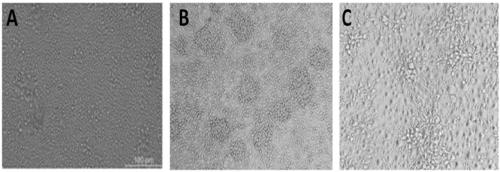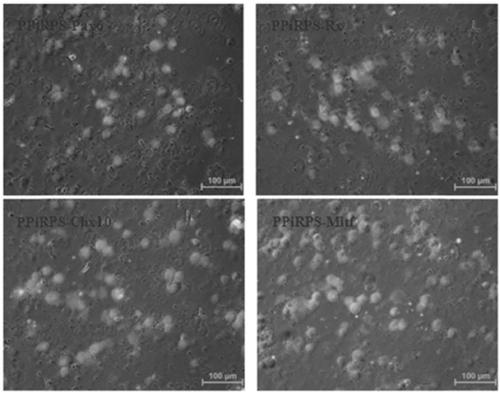Method, kit and application of reverse differentiation of blood mononuclear cells to produce human blood-derived autologous retinal stem cells
A nuclear cell, retinal technology, applied in biomedicine and biological fields, can solve the problems of immune rejection, poor stability, low yield, etc.
- Summary
- Abstract
- Description
- Claims
- Application Information
AI Technical Summary
Problems solved by technology
Method used
Image
Examples
Embodiment 1
[0067] Example 1 A set of culture solutions for reverse differentiation of human somatic cells to produce autologous retinal stem cells
[0068] Including cell culture fluid A1, cell culture fluid A2 and cell culture fluid A3.
[0069] It is operated in a safe operating table with a cleanliness level of 10 to 100, and is prepared under low temperature conditions of 4 to 10 ℃.
[0070] Preparation of cell culture fluid A1:
[0071] Add the following ingredients to 500mL DMEM culture medium (purchased from GICO company):
[0072] 10μM RHO kinase inhibitor Y-27632 (purchased from Sigma), 10ng / mL stem cell factor (purchased from R&D company), 10ng / mL interleukin 3 (purchased from R&D company), 10ng / mL interleukin 6 (purchased from R&D company), 10ng / mL interleukin 11 (purchased from R&D company), 10ng / mL macrophage colony stimulating factor (purchased from R&D company), 10ng / mL granulocyte colony stimulating factor (Purchased from R&D Company), 10μg / mL fucoidan, (purchased from Sigma Comp...
Embodiment 2
[0079] Example 2 Kit for preparing autologous retinal stem cells
[0080] It includes the cell culture solution A1, the cell culture solution A2, and the cell culture solution A3 in Example 1, and also includes human somatic cells.
Embodiment 3
[0081] Example 3 Method for preparing retinal stem cells using peripheral venous blood
[0082] 1. Source of blood sample: Aseptically collect peripheral venous blood donated by scientific research staff. Before collecting peripheral venous blood, you should obtain the consent of the blood donor or your immediate family members, and record the genetic and infectious history of the blood donor and your family, as well as all relevant virus examination results in the hospital.
[0083] 2. Separation of mononuclear cells: blood samples are separated using Ficoll standard separation technology to separate mononuclear cells as raw cells. The microscopic view of raw cells is as follows figure 1 -A shown.
[0084] 3. Preparation of retinal stem cells:
[0085] Using the cell culture solution A1, cell culture solution A2, and cell culture solution A3 prepared in Example 1;
[0086] Divide the obtained mononuclear cells into 5x10 6 Density, use cell culture medium A1, at 37°C and 5% CO 2 Cultiv...
PUM
 Login to View More
Login to View More Abstract
Description
Claims
Application Information
 Login to View More
Login to View More - R&D
- Intellectual Property
- Life Sciences
- Materials
- Tech Scout
- Unparalleled Data Quality
- Higher Quality Content
- 60% Fewer Hallucinations
Browse by: Latest US Patents, China's latest patents, Technical Efficacy Thesaurus, Application Domain, Technology Topic, Popular Technical Reports.
© 2025 PatSnap. All rights reserved.Legal|Privacy policy|Modern Slavery Act Transparency Statement|Sitemap|About US| Contact US: help@patsnap.com


